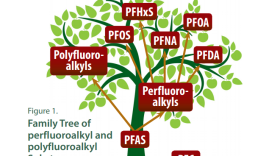U.S. Environmental Protection Agency acting Administrator Andrew Wheeler Thursday laid out the agency’s action plan to address PFAS chemicals. PFOA and PFOS have contaminated drinking water in such New York communities as Hoosick Falls and Newburgh. Environmentalists say the plan doesn’t go far enough, and it’s up to states to take the lead.
EPA Assistant Administrator for Water Dave Ross briefed the press prior to Wheeler’s announcement, saying EPA is moving forward with a maximum contaminant level, or MCL, process for PFOA and PFOS, as part of its PFAS action plan.
“By the end of this year, EPA will propose a regulatory determination, which is the next step required by the Safe Drinking Water Act for establishing an MCL,” Ross says.
EPA Region 2 Administrator Pete Lopez and EPA office of Enforcement and Compliance Assurance Assistant Administrator Susan Bodine discussed Wheeler’s announcement with reporters, community members and elected officials. Hoosick Falls Mayor Rob Allen was on the line.
“What is preventing EPA right now from setting an MCL for PFOA and PFOS at 70 parts per trillion right now, today,” Allen asked.
The EPA’s current health advisory for PFOA and PFOS in drinking water is 70 parts per trillion. Bodine says the EPA rulemaking process has steps to follow and is at the following point.
“Now we have to make a determination that the PFOA/PFOS meets the, are appropriate for regulation,” says Bodine. “That’s the regulatory determination and that is what, that’s the action we’re going to take this year and then we, the final step is picking out the number.”
“Everything in their action plan today says we propose, we anticipate, in the future we are going to consider doing this, but there’s no real action,” Andrews says.
That’s Dr. David Andrews. He’s a senior scientist with Washington, D.C.-based Environmental Working Group and has worked on PFAS chemicals for a decade.
“It’s a historic action plan from EPA that’s lacking any action. And so, from our perspective, this really does nothing to protect public health,” Andrews says. “And it’s extremely concerning because it was close to a year ago where Administrator Scott Pruitt called PFOS a national crisis and one that needed urgent action. And yet the plan today reflects exactly the same talking points he had nine months ago.”
Meantime, Hoosick Falls resident Michael Hickey, who brought to light the PFOA contamination crisis in his community, was on the EPA regional call.
“We’ve had action here but my concern is preventing additional illnesses from occurring in other communities and it seems like there’s enough out there, and it’s frustrating that this can’t be done more quickly, and I just don’t quite understand it,” Hickey says.
Bodine responded.
“So I understand your frustration, federal regulatory processes, but that is a given if we’re going to be able to establish national standards and, again, meet the requirements of statues using the best available science and making sure that the standard we set is going to actually provide a public health benefit,” says Bodine.
Joe Donat is interim city manager of Newburgh, which has been grappling with a PFOS water contamination crisis since 2016.
“My colleagues in government, our congressman and our t wo senators will remain adamant on the city’s side in this matter,” Donat says. “And the city of Newburgh will continue its dialogue with the state to work on a resolution moving forward.”
He’s referring to his former boss, Democratic Congressman Sean Patrick Maloney, whose 18th District includes Newburgh. Maloney, in a statement, says, in part, “I appreciate the fact that the EPA is finally getting in the game on PFOS and PFOA cleanup criteria, but we need an enforceable drinking water standard to protect our communities right now.”
In December, the New York State Drinking Water Quality Council recommended MCLs for three chemicals — 10 parts per trillion each for PFOA and PFOS, emerging contaminants found in Hoosick Falls and Newburgh, respectively. The council also voted to recommend an MCL of 1 part per billion for 1,4-Dioxane. Liz Moran is environmental policy director for the New York Public Interest Research Group.
“It was over a year-and-a-half ago that the governor first said, in the face of federal inaction, New York state would step up and lead,” says Moran. “But unfortunately, since that was said, it’s been repeated on numerous occasions, and Hoosick Falls and Newburgh residents are still waiting for that very leadership that’s been promised.”
A state Department of Health spokeswoman, in an emailed statement says, “Unfortunately, lack of federal leadership has further clarified that New York must continue to chart our own course to set protective levels for emerging contaminants in drinking water. Today’s announcement neither deters, nor further influences, our decision moving forward. We are on target to adopt the most protective levels for PFOA/PFOS, as well as recommending the first-ever level for 1,4-dioxane and expect to reach decisions for both soon following the rulemaking process.”









